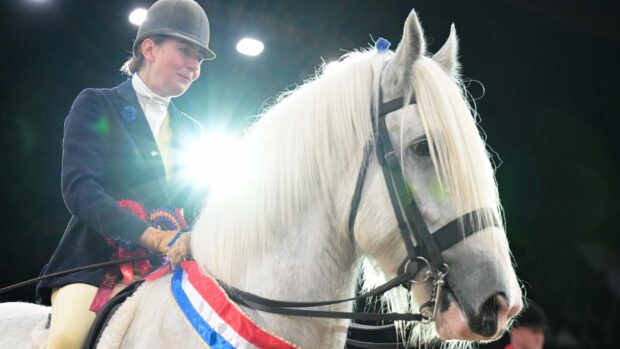The Shire horse is a British draught horse, thought to originate in Lincolnshire and Cambridgeshire, although like many old breeds, its exact foundations are unknown.
It is believed to have descended from “the Great Horse,” a popular war mount from the Middle Ages. However, the invention of gunpowder eliminated the need for a heavy horse in combat, and as cavalries turned to lighter mounts, the larger horses were increasingly used in agriculture or for pulling heavy carts.
The Great Horses were probably crossed with Friesians and other breeds to create a powerful draught animal called the Old English Black Horse in the 17th century. By the late 18th century, a stallion called the Packington Blind Horse was standing at stud in Leicestershire. He is recognised as the foundation sire of the Shire horse breed.
A studbook was established by the English Cart Horse Society (which changed its name to the Shire Horse Society) in 1878, but with records going back to 1701. During the 19th century, Shires were used to pull anything heavy, more or less keeping the industry and infrastructure of the UK running until the invention of the internal combustion engine. They moved heavy goods from the docks to the cities and countryside; they hauled goods to and from the railways; they pulled barges; they pulled trams and omnibuses; they collected rubbish from big cities; they worked in fields; and they were extremely popular as dray horses, hauling ale from the brewery to the pubs.
Like many draught breeds, the mechanisation of agriculture following the Second World War decimated their numbers. Once there had been over a million Shires in the UK and United States, but by the 1950s and 1960s, there were only a few thousand left.
The Shire Horse Society and other societies began a campaign in the 1970s to save the breed, promoting the horses as not just as draught animals, but willing and kind riding mounts, and encouraging breweries to continue using them. But even now, the breed is far from out of the woods. The Rare Breeds Survival Trust said in 2018 that only 240 Shire foals were registered in the UK the previous year. Encouraging horse owners to buy heavy draught horses isn’t an easy task — they are more expensive than light horses to feed and shoe and may require custom tack.
The RBST says on its website: “These numbers are in stark contrast to the 2.6 million heavy horses being used in agriculture and trade at the dawn of the 20th century. The mechanisation of farming and warfare has meant that the original purposes of heavy horses may be a thing of the past, but these large horses have an essential role to play today, including in the army, policing, equine therapy and commercial logging.”
The most obvious — and for some, off-putting — traits of the Shire are its size and strength. They are usually around 17hh to 17.3hh, although the tallest horse in the world is a Shire called Duke who stands at 19.3hh. But he’s not even the largest Shire ever recorded — a Shire called Mammoth, born in 1848, was reported as being 21.2hh.
They are majestic horses, with a high, arched neck, well sprung ribs, powerful, sloping hindquarters, and heavy feathering on the legs. In the 20th century, Clydesdale blood was introduced, which made the feathering silkier. They are extremely strong — a pair of Shires in the 1920s allegedly pulled a load weighing more than 45 tons.
However, they are typically gentle giants, calm and friendly with an even temperament. A horse bred for a couple of hundred years to pull heavy loads through city streets should not be spooky or hot, and consequently most Shires are intelligent and steady. At the same time, they are sensitive and eager to please and can be forward-going.
When crossed with Thoroughbreds and other light horses, they can produce an athletic weight-carrying sport horse or heavyweight hunter. British Olympic dressage rider Carol Parsons bought two Shire/TB crosses, called Walter and Giddy, and trained them all the way to grand prix, competing successfully at CDI levels. Walter placed fifth in the grand prix and freestyle at the Hickstead CDI in 2004, while Giddy was second at the nationals in 2005 and 2006 and then became the Hickstead Dressage Masters Champion in 2008.
Some breweries still use Shire teams to pull drays, for local deliveries and for promotional purposes. These include Thwaites, Wadworth, Samuel Smith’s, and Harvey’s. Some small farms have gone back to horse power, utilising Shires and other draughts instead of tractors, as horses are more environmentally sustainable. Shires are also still used in logging, accessing areas that a vehicle can’t get to.
Every year, the National Shire Horse Show takes place in March at the Staffordshire County Show Grounds. Around 250 entries attended the show last year. In BSHA shows, there are classes for ridden heavy horses, which a Shire would be eligible for. While most full Shires don’t have the collection ability for upper level dressage, they are big movers and forward, so they make fun lower level mounts. British Dressage now runs the Draught Horse Championships, open to any draught breed, with classes from intro to elementary.
Like other heavily-feathered horses, Shire horses are vulnerable to feather mites and mud fever. They are also prone to polysaccharide storage myopathy (PSSM), a genetic glycogen storage disease that causes tying up and reluctance to work. It is incurable, but manageable with the correct diet.
You might also be interested in:

Cobs: everything you need to know about this versatile type
Here's everything you need to know about cobs

Subscribe to Horse & Hound magazine today – and enjoy unlimited website access all year round




